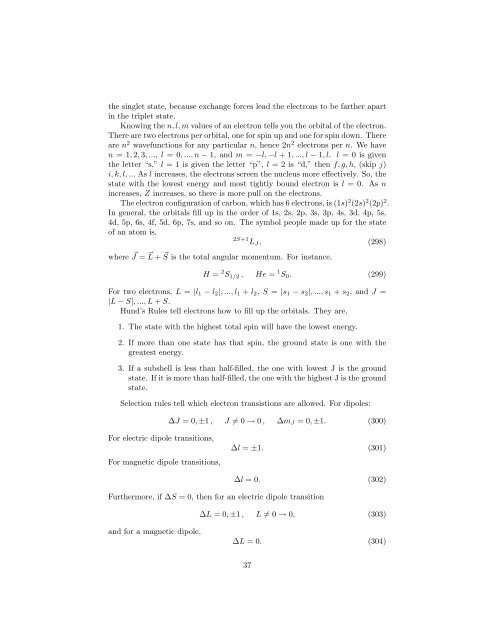Notes for the Physics GRE - Harvard University Department of Physics
Notes for the Physics GRE - Harvard University Department of Physics
Notes for the Physics GRE - Harvard University Department of Physics
You also want an ePaper? Increase the reach of your titles
YUMPU automatically turns print PDFs into web optimized ePapers that Google loves.
<strong>the</strong> singlet state, because exchange <strong>for</strong>ces lead <strong>the</strong> electrons to be far<strong>the</strong>r apartin <strong>the</strong> triplet state.Knowing <strong>the</strong> n, l, m values <strong>of</strong> an electron tells you <strong>the</strong> orbital <strong>of</strong> <strong>the</strong> electron.There are two electrons per orbital, one <strong>for</strong> spin up and one <strong>for</strong> spin down. Thereare n 2 wavefunctions <strong>for</strong> any particular n, hence 2n 2 electrons per n. We haven = 1, 2, 3, ..., l = 0, ..., n − 1, and m = −l, −l + 1, ..., l − 1, l. l = 0 is given<strong>the</strong> letter “s,” l = 1 is given <strong>the</strong> letter “p”, l = 2 is “d,” <strong>the</strong>n f, g, h, (skip j)i, k, l, ... As l increases, <strong>the</strong> electrons screen <strong>the</strong> nucleus more effectively. So, <strong>the</strong>state with <strong>the</strong> lowest energy and most tightly bound electron is l = 0. As nincreases, Z increases, so <strong>the</strong>re is more pull on <strong>the</strong> electrons.The electron configuration <strong>of</strong> carbon, which has 6 electrons, is (1s) 2 (2s) 2 (2p) 2 .In general, <strong>the</strong> orbitals fill up in <strong>the</strong> order <strong>of</strong> 1s, 2s, 2p, 3s, 3p, 4s, 3d, 4p, 5s,4d, 5p, 6s, 4f, 5d, 6p, 7s, and so on. The symbol people made up <strong>for</strong> <strong>the</strong> state<strong>of</strong> an atom is,2S+1 L J , (298)where ⃗ J = ⃗ L + ⃗ S is <strong>the</strong> total angular momentum. For instance,H = 2 S 1/2 , He = 1 S 0 . (299)For two electrons, L = |l 1 − l 2 |, ..., l 1 + l 2 , S = |s 1 − s 2 |, ..., s 1 + s 2 , and J =|L − S|, ..., L + S.Hund’s Rules tell electrons how to fill up <strong>the</strong> orbitals. They are,1. The state with <strong>the</strong> highest total spin will have <strong>the</strong> lowest energy.2. If more than one state has that spin, <strong>the</strong> ground state is one with <strong>the</strong>greatest energy.3. If a subshell is less than half-filled, <strong>the</strong> one with lowest J is <strong>the</strong> groundstate. If it is more than half-filled, <strong>the</strong> one with <strong>the</strong> highest J is <strong>the</strong> groundstate.Selection rules tell which electron transistions are allowed. For dipoles:∆J = 0, ±1 , J ≠ 0 → 0 , ∆m J = 0, ±1. (300)For electric dipole transitions,For magnetic dipole transitions,∆l = ±1. (301)∆l = 0. (302)Fur<strong>the</strong>rmore, if ∆S = 0, <strong>the</strong>n <strong>for</strong> an electric dipole transition∆L = 0, ±1 , L ≠ 0 → 0, (303)and <strong>for</strong> a magnetic dipole,∆L = 0. (304)37
















